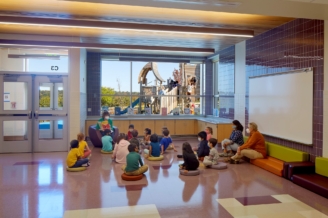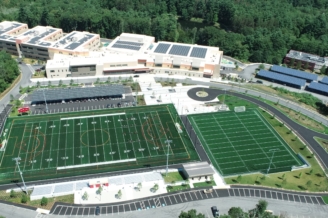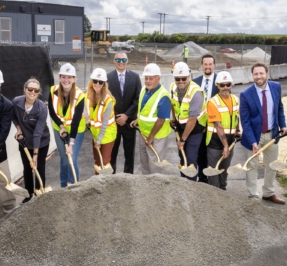Advancing to Zero Net Energy Buildings
Over the past 43 years LPA has been committed to designing sustainable buildings by using a wide range of techniques and strategies to ensure control of energy sources, reduction of energy costs, and protection against climate change. Now, we are charged with the ultimate challenge to design one of the first public elementary schools in the state with the goal of zero net energy.
According to the Massachusetts Zero Net Energy Buildings Task Force, a zero net energy (ZNE) building is one that is optimally efficient and, over the course of a year, generates energy onsite, using clean renewable resources, in a quantity equal to or greater than the total amount of energy consumed onsite.
With the impacts of global warming becoming more evident, it is important to find new ways to create clean and local energy, as well as reduce our energy consumption. Buildings contribute 30 percent of greenhouse gas emissions and consume nearly 40 percent of energy in the US. To avoid potential negative consequences, energy efficiency and renewable energy technologies should become commonplace in the way we design and build.
According to the New Buildings Institute 2014 Research Report, in the US and Canada there are currently 32 ZNE verified buildings and 110 ZNE emerging buildings ranging from homes and office buildings to libraries and schools.
In November of 2013, Lamoureux Pagano Associates was selected by the Massachusetts School Building Authority (MSBA) in conjunction with the City of Worcester to conduct a Feasibility Study through Schematic Design for the Nelson Place Elementary School. Well beyond the threshold for 2% additional reimbursement for green design, the City of Worcester has established a zero net energy target for the project.
To address the strategies and opportunities for achieving zero net energy for the Nelson Place School, LPA organized a workshop charrette in January with a diverse spectrum of participants. Since then, options have been analyzed to develop the best opportunities for the school’s program and site.
As Julie Lynch, an architect with the City of Worcester, explains, “A large capital project, such as the new Nelson Place School, provides an opportunity for the City to develop best practices for energy efficient design to inform future projects in both the public and private sector.”
Nelson Place School provides an excellent opportunity to showcase sustainable design targets as outlined in local, state, and federal action plans. Potential on-site strategies considered for this analysis have included:
- Optimal Orientation
- Passive Strategies; shading, thermal mass, and daylighting/skylights & natural ventilation
- Maximum Efficiency of Building Envelope, Lighting and Ventilation System
- Power Purchase Agreement
- Solar Photovoltaic / Solar Hot Water
- Wind Power / Microhydro Power
- Geothermal System
- Collection and Re-use of Rain Water
- Green Roof
- Fuel Cell Generator
- Co-Generation System
- Chilled Beam / Chiller System
- Micro-hydro power
- Bio-mass/Digestion System
- Sale of Renewable Energy Credits (RECs)
As the project develops, the most appropriate strategies for Nelson Place School will be incorporated.
When describing the city’s motivation behind a zero net energy school, Julie Lynch noted that the City of Worcester is a Green Community and in 2006 adopted a Climate Action Plan which states, “We can reduce the pollution that causes global warming by using currently available technologies that also enhance economic development. In our schools, homes and places of work, we can implement energy efficiency measures, use renewable energy, and increase waste recycling to pollute less and save money. These measures are not in conflict with economic development; instead, they are the basis on which our future economic development and quality of life will rely. Our actions can be an example to others, inspiring responsible energy and resource consumption. “
She further noted that, “By achieving a more efficient school building as a result of the Zero Net goal, and as the cost of energy will surely rise in the future, the City will benefit from a reduction in operating costs through the use of electricity and heat provided by renewable resources.”
Examples of recent successful sustainable projects designed by LPA include the Sherwood Middle School in Shrewsbury which features a highly efficient insulated metal panel exterior wall system and a low tech solar wall application to reduce energy costs. In Ashburnham, the J.R. Briggs Elementary School incorporated a wood pellet boiler system that takes advantage of a locally available fuel source. For both of these projects MA-CHPS (Massachusetts Collaborative for High Performance Schools) ratings were received, garnering reimbursements from the state.
With six LEED Accredited Professionals on staff, LPA has successfully used a design charrette approach to review and evaluate all sustainable options, and to determine the best solution. From decisions made at these charrettes, the Mountview Middle School in Holden, soon to start construction, will utilize photovoltaic panels estimated to produce 50% of the energy for the building; and Auburn Middle School, in the early construction phase, was designed to include a 1500-foot deep geothermal well dedicated to heating and cooling the building as an alternate.
Five years ago the Commonwealth of Massachusetts established the Zero Net Energy Buildings Task Force to “provide recommendations that would point the way toward universal adoption of zero net energy buildings for new residential and commercial construction by 2030.” For the Nelson Place Elementary School, LPA is excited to be a part of this important long-range goal and look forward to studying the opportunities for it to become a verified zero net energy building.
“Less energy usage isn’t enough. We have to set our sights not higher, but lower – all the way to zero.”
– Massachusetts Governor Deval Patrick
Categorized In: News
Tagged In: K-12 Schools, Sustainable Design, Worcester
Share This










